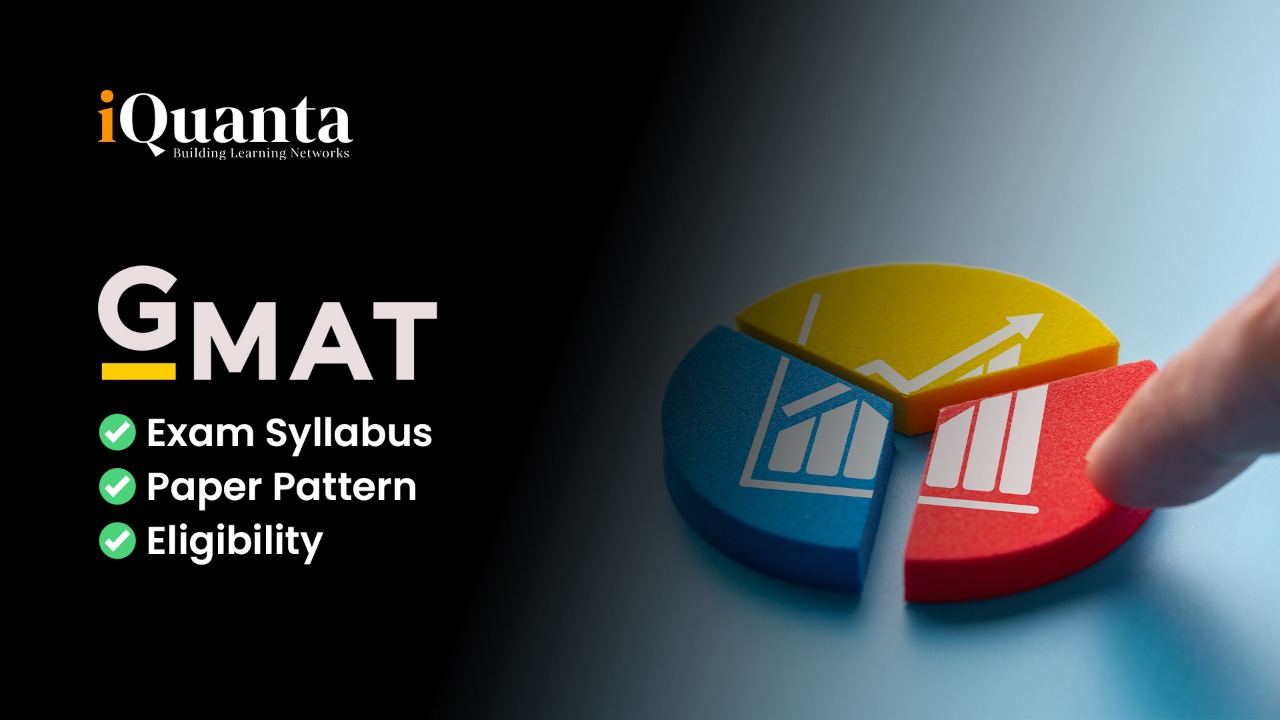GMAT exam is a computer-adaptive exam. It evaluates the candidates for quant, verbal, analytical writing and reasoning skills. This exam has to be taken in English. The GMAT exam syllabus is vast, but defined.
Graduate Management Test is the basis to gain admission in management programs like MBA, Masters of Finance, Masters of Accountancy in top business schools around the globe.
It is held in 114 countries around the world and is the first choice of MBA aspirants. So, we thought of creating this blog and sharing all about the GMAT exam – details, eligibility, and syllabus.
What is the GMAT Exam?
Graduate Management Test or GMAT exam is the criteria for admission to graduate programs in numerous business schools globally. A high score increases the candidate’s probability of entry into the top business schools.
However, this test is different from all the entrance exams designed for b-schools. To ace the GMAT and score higher, you have to adopt a rational approach to display your skills. And remember, you have limited attempts to appear for this test. So, sit for the GMAT exam only after you are thoroughly prepared.
How Is the GMAT Exam Different From Other Entrance Exams?
Entrance exams are usually knowledge-based and require thorough learning of facts and figures. GMAT is a skill-based exam. In a nutshell, this exam is not possible to be cleared by the good old memorization technique or by rote learning the facts. You need to put in extra effort and follow a different approach.
Get the GMAT Online Coaching by iQuanta
You have to think quickly, detailed, and strategically. The test requires you to be wise, logical, and accurate. GMAT exam basically tests your mathematical, verbal, and writing abilities that you learned through your high school education. The only difference is that the questions based on the same concepts of senior school studies are now profound and complex for this skill-based standard test. You have to be fully aware, comprehend, and answer the questions in a limited time.
Competency required to ace GMAT cannot be mastered from any book, but by practice, consistency, and focus.
Exam Features
Now that you understand what GMAT is, let’s look at some of its prominent features.
| It is an online exam that uses advanced technology. |
| GMAT offers flexibility to take the exam. It can be taken from home or at a test center. |
| It has a fair marking system, as it is delivered by means of a computer. |
| Candidates can take the test as per their convenient time of year. |
| By keeping track of time, one can figure out the number of questions that can be answered. |
| Unofficial scores are available soon after the exam. |
| You get questions as per your ability level. But you can neither skip a question nor go back to the previous one. |
| There are fewer questions in GMAT tests than other entrance exams. |
| It doesn’t give you the option to see all questions at a time. So, you do not waste time thinking which question is easy or difficult for you to solve. |
| Every individual gets a different set of questions chosen by the computer according to their ability. |
| Each test is unique, and hence the level of security increases. |
Note: During the GMAT exam, a candidate can take two ‘8 minute breaks’.
GMAT Exam Pattern, Syllabus and Eligibility
Let’s take a look at the GMAT exam syllabus, pattern, and eligibility in detail.
Exam Pattern
In GMAT test, the candidates are assessed in 4 sections:
- Quantitative Reasoning
- Verbal Reasoning
- Analytical Writing Assessment
- Integrated Reasoning
The total time allotted for the GMAT exam is 2 hours and 15 minutes, with 2 breaks of 8 minutes each. Check the table below for the time limit given for each section:
| Sections | Number of Questions | Time Limit |
| Analytical Writing Assessment | 1 essay | 30 min. |
| Integrated Reasoning | 12 questions | 30 min. |
| Quantitative Reasoning | 31 questions | 62 min. |
| Verbal Reasoning | 36 questions | 65 min. |
| Total Time | 187 min. | |
The quantitative reasoning and verbal reasoning sections comprise only of multiple-choice questions. The questions are computer-adaptive and are adjusted according to the individual’s aptitude.
The candidate is free to pick up the section sequence. No one sequence has been proven better than the other. These are the section sequences you can decide from:
- Analytical Writing Assessment > Integrated Reasoning > Quant > Verbal
- Verbal > Quant > Integrated Reasoning > Analytical Writing Assessment
- Quant > Verbal > Integrated Reasoning > Analytical Writing Assessment
Exam Syllabus
Many MBA aspirants, across the globe, appear for the GMAT exam. It is the basis to get them in their dream business school. A 3 hour 7 minute test with a minimum score of 800 points is divided into four sections, namely:
- Quantitative Reasoning
- Verbal Reasoning
- Analytical Writing Assessment
- Integrated Reasoning
Though the GMAT exam syllabus of the four sections is comprehensive, yet it is defined. By following a structured study plan, it is possible to complete the entire exam syllabus within 4 to 5 months.
NEW GMAT EXAM PATTERN 2024
The new exam pattern has been introduced in 2024 as ‘GMAT Focus Edition’. There is a slight difference in exam pattern of GMAT Focus Edition vs GMAT exam pattern which used to come.
You can go through the new GMAT Focus Edition 2024 exam pattern in the table below.
| GMAT Focus Edition | Number of Questions | Time |
| Quantitative Reasoning | 21 Questions | 45 Minutes |
| Verbal Reasoning | 23 Questions | 45 Minutes |
| Data Insights | 20 Questions | 45 Minutes |
| Total | 64 Questions | 2 hours 15 minutes |
Quantitative Reasoning
The GMAT quantitative reasoning section evaluates the aspirant’s capacity to solve quantitative problems and interpret graphical data. It has 2 parts with multiple-choice questions:
| Problem-Solving |
| Data Sufficiency |
Acing this section requires basic knowledge of arithmetic, elementary algebra, and commonly known concepts of geometry. Refer to the table below for the complete quant syllabus:
Verbal Reasoning
The GMAT verbal reasoning section measures the candidate’s ability to read and comprehend, reason and logically evaluate the presented arguments in passages. It consists of 3 parts, each with numerous multiple-choice questions:
| Critical Reasoning |
| Sentence Correction |
| Reading Comprehension |
- Critical Reasoning – It is the test to analyze an individual’s ability to reason logically through an argument and answer objectively, while avoiding personal opinion when attempting to answer the question.
- Reading Comprehension – This is a test designed to evaluate the aspirant’s ability to read and comprehend the concepts quickly. The given passages are generally between 200–350 words, and have multiple questions to answer. The candidates are tested on the following reading skills:
| Interpretation of the information in the given passages |
| Understanding the main idea |
| Forming a logical structure |
| Following the development of quantitative concepts |
- Sentence Correction – This part is a single-sentence correction question, and the words with errors are underlined. It measures an individual’s language proficiency by testing:
| Their efficiency in correcting sentences is grammatically and structurally correct. |
| Their understanding of effective and concise expression of an idea. |
The areas covered in GMAT Verbal Reasoning are:
|
|
|
|
|
|
|
|
Analytical Writing Assessment
The GMAT analytical writing assessment section is a test of your writing style. You will be asked only 1 question in this section. In a limited time of 30 minutes, you have to comprehend, analyze, think quickly and critically, and write the essay, reinforcing the idea with the facts and logical examples.
Integrated Reasoning
The GMAT integrated reasoning section evaluates your ability to understand and evaluate multiple sources and types of information – graphic, verbal or numeric – in relation to each other. It is a test designed to examine your capacity to assess the facts and figures presented as graphs and tables.
This section is divided into 4 parts with 12 questions:
| Table Analysis: It tests your ability to sort and analyze data. |
| Graphic Interpretation: It tests your ability to interpret information presented in a graph. |
| Multi-source Reasoning: It tests your potential to understand and evaluate data from a combination of different sources – tables, graphics, and text |
| Two-Part Analysis: It presents complex problems that can either be verbal, quantitative or a combination of both. |
Now that you have detailed information about the GMAT syllabus, we are sure it would help you prepare for the exam better.
For further assistance with preparation material and live classes, check out iQuanta’s GMAT courses.
Exam Eligibility
There is no eligibility criteria set by GMAC to appear for GMAT. Moreover, GMAC does not discriminate against the candidates appearing for this exam. Hence, any individual, irrespective of age, nationality, gender, religion, academic background or disability, can take the GMAT test.
Still, for your convenience, we have discussed in detail the various eligibility factors for the GMAT exam.
Age Limit
The minimum age limit for the candidates to appear for the GMAT exam is 18 years, as defined by the Graduate Management Admission Council. But there is no upper age limit to sit for this test.
Academic Eligibility
There is no specific academic eligibility defined by GMAC for appearing for the GMAT exam. However, the aspirants who appear for GMAT are usually:
- Final year undergraduate students, and
- Working professionals who wish to upskill their qualification
Even if you do not fall under these categories, you are still permitted to sit for this exam. The only restraint is that you cannot take GMAT after completing 12th or high school. You need an undergraduate degree to qualify for taking the GMAT exam.
Scores Required
There are no requirements for cut-off marks for taking this test. However, candidates are advised to check the minimum score eligibility when applying to business schools.
Work Experience
Mostly, it is the professionals who take the GMAT to upgrade their education qualification. But, having no work experience is not a hindrance to appear for the GMAT test. However, having some prior work experience is always an added advantage.
Language Requirement
This exam has to be taken in English. Thus, the aspirants preparing for this exam should have a basic understanding of the language. One should be proficient in English to comprehend and answer the complex questions asked in the test.
GMAT Fees – Registration, Rescheduling and Cancellation
As GMAT is a common entrance exam for B-schools across the globe, the fee varies from country to country.
Check out the table below for the GMAT exam cost in India:
| GMAT Fee Category | Total Fee Amount |
| Registration (Test Center) | $275 |
| Registration (Online) | $300 |
| Rescheduling (Test Center) | $55 (60 days before the scheduled test)
$110 (15-60 days before the scheduled test) $165 (14 days prior to the test) |
| Rescheduling (Online) | $60 (60 days before the scheduled test)
$120 (15-60 days before the scheduled test) $180 (14 days prior to the test) |
| Cancellation (Test Center) | $110 refund (60 days before the scheduled test)
$80 refund (15-60 days before the scheduled test) $55 refund (14 days prior to the test) |
| Cancellation (Online) | $120 refund (60 days before the scheduled test)
$90 refund (15-60 days before the scheduled test) $60 refund (14 days prior to the test) |
| Enhanced Score Report | $30 |
| Additional Score Report | $35 each |
| Cancel Score (Test Centre)
(via mba.com My Account page after the exam) |
$25 |
| Cancel Score (Online) | Not Applicable |
| Reinstate Score (Test Center) | $50 |
| Reinstate Score (Online) | Not Applicable |
| Re-scoring for AWA Essay | $45 |
The test appointment cannot be canceled within 24 hours of the scheduled date and time
The figures in INR will vary according to the exchange rate at the time of registration.
For MBA aspirants, who are working full-time, check-out iQuanta’s GMAT course for GMAT exam syllabus preparation.




